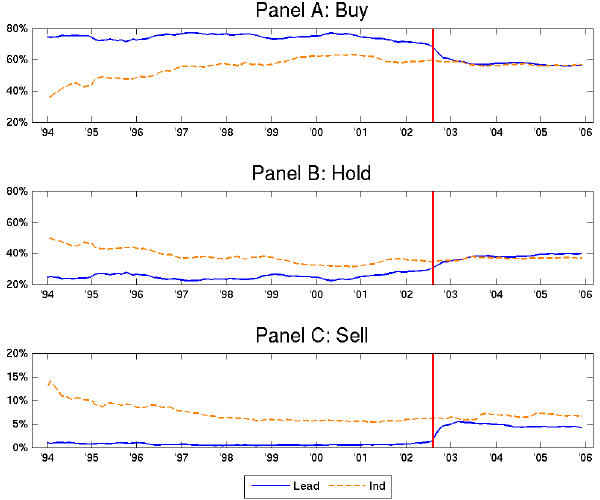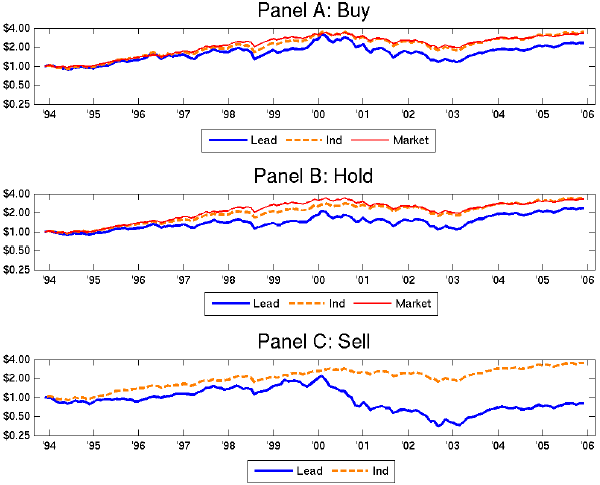Do broker stock recommendations predict future returns? Are analysts at independent brokers more accurate than those associated with investment banking firms? Did the changes in research rules after the Internet bubble affect analyst behavior? In his November 2006 paper entitled “Do Affiliated Analysts Mean What They Say?”, Michael Cliff compares the performance of stock recommendations made by analysts employed by lead underwriters to that of recommendations made by analysts working at independent brokers. Using data for the period 1994-2005 (13,794 recommendations from lead underwriters and 10,216 from independent brokers), he finds that:
- The median recommendation life is six to nine months. Since the conflict-of-interest rule changes of NASD rule 2711, the distribution of recommendations from both lead underwriters and independent brokers is about 55% buy, 40% hold and 5% sell. Over 90% of coverage initiations by lead underwriters are buy, compared to 75% for independents brokers.
- Buy and hold recommendations from lead underwriters underperform both the market and the buy and hold recommendations from independent brokers by about 0.25% per month (risk-adjusted).
- Sell recommendations from lead underwriters underperform both the market and the sell recommendations from independent brokers by about 0.70% per month (risk-adjusted).
- Over a three-day announcement period:
- Buy recommendations of lead underwriters (independent brokers) produce an abnormal return of +1.2% (+0.6%). These returns are larger since NASD rule 2711.
- Hold recommendations of lead underwriters (independent brokers) produce an abnormal return of -7.1% (-1.4%). These returns are less negative since NASD rule 2711.
- Sell recommendations of lead underwriters (independent brokers) produce an abnormal return of -6.2% (-2.1%).
The following set of charts, taken from the paper, shows the distribution of recommendations from lead underwriters (Lead) and from independent brokers (Ind). The solid vertical line marks implementation of most of the requirements of NASD rule 2711, designed to eliminate conflicts of interest for lead underwriters. The charts show that, prior to the rule changes, lead underwriters presented a much more positive distribution than did independent brokers.

The next set of charts, also from the paper, compares the values over time of a $1 initial investment in the buy, hold and sell recommendations from lead underwriters (Lead) and from independent brokers (Ind). The portfolios are formed based on recommendations between 1994 and 2005, rebalanced daily to reflect recommendation changes. The thin line indicates the value of a benchmark value-weighted market portfolio. The charts show that lead underwriter (independent broker) buy and hold recommendations underperform (match) overall market performance. Lead underwriter (independent broker) sell recommendations dramatically underperform (match the performance of) their buy and hold recommendations.

In summary, lead underwriter sell recommendations may be the only analyst calls worth tracking.